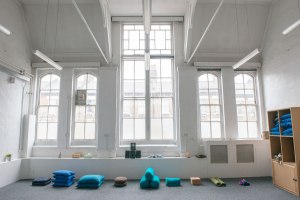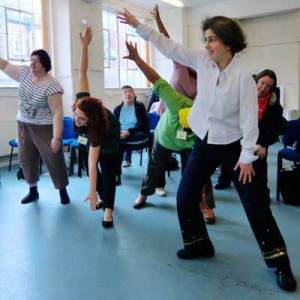This is an article I wrote for the British Wheel of Yoga Wales Region newsletter.
 I’m a bit in love with the Special Yoga Foundation and its people. For a while I thought I might keep them as my little secret because they are precious to me…. But then, Gollum never did yoga, did he – otherwise he might have been saved?
I’m a bit in love with the Special Yoga Foundation and its people. For a while I thought I might keep them as my little secret because they are precious to me…. But then, Gollum never did yoga, did he – otherwise he might have been saved?
In September I went to London for a three day intensive workshop, entitled “Yoga for Adults with Special Needs” at the Special Yoga studio in Kilburn Lane. Thirty years ago I had a boyfriend who bought a house near Queens Park (just down the road). If he hung on to it, good luck to him, they now sell for £3,000,000!

The workshop was open to people like me, i.e. yoga teachers with no expertise in teaching special needs students, people who already worked with the special needs population but with little or no knowledge of how yoga might fit in, and finally people who already did both but wanted a deeper understanding.
The course leader was Richard Kravetz. Like me, Richard is a member of the British Wheel of Yoga– he used to be a County Rep. In 1988 his second son, Matthew, was born with global development delay. Looking after Matthew, and meeting other parents of special children like Matthew, fired Richard’s passion for bringing the benefits of yoga to this very diverse population. You might have read his article in the current issue of Spectrum on the BWY initiative on dementia – Richard is interested in all aspects of special yoga – from children to the elderly, and I warn you now that he is seriously inspiring.
The curriculum for the workshop looked at working with both ambulatory and non-ambulatory groups, and for people in high and low arousal. The course looked at providing yoga for people with autism, add and adhd, Downs syndrome, cerebral palsy, depression, sensory impairment and dementia.
We were privileged to watch a live class, and view two of Richard’s classes on video. We became his students for one session of chair yoga and we also had a session of touch and simple massage (Tui Na) techniques to support the yoga, taught by another Special Yoga tutor, Christine Godwin.

Richard explains that adults with learning difficulties are trapped in their bodies, have shallow breathing habits and disorganised mental patterns. He says, ‘The effect of medication, accidents and past trauma often results in a heightened state of stress and reactivity, where the individual is trapped in a state resistant to change, and they exist in survival mode to cope with their fear …. The person can become anxious about minor matters and is unable to listen or respond to stimulus’.
So how does yoga help? There are eleven strategic areas:-
- Improved motor planning and control
- Improved self-awareness – body and mind
- Develop ability to self-regulate across environment and demands
- Develop a sense of balance and perspective
- Develop ability to relax and release tension, fear and frustration
- Reduce stress reaction and improve resilience
- Improve immune function
- Improve quality and quantity of sleep
- Enhance respiratory ability and capacity
- Enhance a sense of wellbeing, calm and peace
- Enhance a sense of emotional balance
Richard stresses the importance of chanting when teaching a special group. It’s good for regulating the breath and improving lung function, but it also promotes connection and integration. We sang the ‘Om Song’, together with hand movements and combined with group members’ names. Chanting someone’s name improves concentration and self-esteem. Not all chants are appropriate, but Hari Om, Om, Om Shanti and Namaste can all be freely used.
Positive affirmations are another good way of removing negative energy and promoting self-esteem. I AM HEALTHY! I AM STRONG! I AM FULL OF ENERGY! I AM HAPPY! I AM SAFE. Building flowing sequences can tap into group dynamics, especially when used with counting out loud and sounding the breath. A sense of fun is obligatory.
A yoga teacher teaching a special group needs the gravitas to hold the space. Richard emphasised again and again the importance of our own personal practice. ‘The importance of self-practice is crucial for the practitioner. A regular practice of Yoga, Pranayama and Meditation is advocated as it helps the teacher to be physically and emotionally stable and in an optimal state to teach. From a solid and grounded base the teacher is in a position to help others effectively with the intention of supporting the healing of their student using composure, respect, love and compassion.’
Here we all are with our course certificates:

I have borrowed heavily from the Course Workbook – as you can see. Yes, I will share them with you:- Special Yoga is at Moberly Studio, 101 Kilburn Lane
London W10 4AH
Phone: 0208 968 1900
Email: info@specialyoga.org.uk
http://www.specialyoga.org.uk
![]()